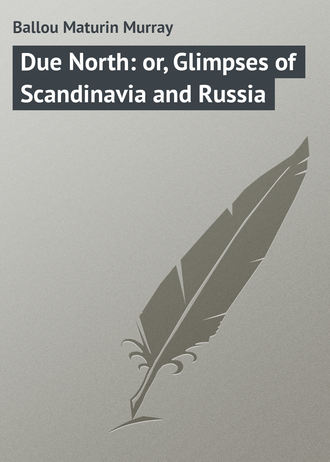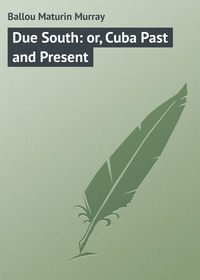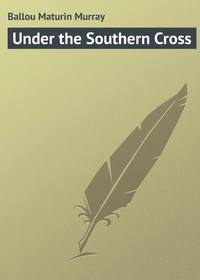 полная версия
полная версияDue North: or, Glimpses of Scandinavia and Russia
It is here at Bergen that the cargoes of fish caught on the coast at the far North and within the Arctic Circle are packed and reshipped to European ports. Lobsters are trapped in immense quantities just off the coast, whence the London market is mostly supplied. We were told that over two millions of this product were annually exported to Great Britain. They are shipped alive to England, where owing to some attributed excellence they are specially favored above those coming from any other locality. The Fish Market is the great business centre of Bergen, situated at the end of the Torv, at a small pier called Triangelen. The fish intended for local domestic use are kept alive in large tubs of water near the shore, and when desired by the purchaser are scooped out with a net, killed by a sharp blow upon the head, and sold by weight, the price being ridiculously low. Owing to its topographical character and location, Bergen will never become a railroad centre; its principal trade will remain in connection with the sea alone. Ship-building is carried on here to a considerable extent. We saw one iron steamer which was constructed and equipped in this harbor; and a finely finished craft she was, of over a thousand tons burden. There are some fine public squares, a People's Park, wherein a military band plays twice a week, half-a-dozen churches, a commodious Theatre, a Royal Palace, a Musical Institute, a Public Library, and a Museum; but there is scarcely a trace of architectural beauty in all Norway with the exception of the cathedral at Tröndhjem, which is formed of a mixture of orders, the Norman predominating. The Church of St. Mary is only interesting for its antiquity, dating as it does from the twelfth century. Its curious and grotesque façade bears the date of 1118.
A glance at the map will show the reader that Norway is broadest where a line drawn eastward from Bergen would divide it, giving a width of a little over two hundred and eighty miles, while the length of her territory is four times as great. The Gottenburg liquor-system, as it is called, has long been adopted in this city, and seems to operate as advantageously here as in the place of its origin. Nevertheless, the people are what we call in America hard drinkers, though little absolute drunkenness was observable. The quaint little shops of the town, which are slightly raised above the level of the street, have another and rather inferior class of stores under them, accessible by descending steps from the thoroughfare. This division of trade, by arranging a series of basement stores, is so common here as to form a feature of the town; and the same is observable in Copenhagen, where many jewelry, art, and choice retail stores are located in the basement of the houses, with an establishment devoted to some other line of trade above them. The shops in Bergen are well filled with odd antique articles, mostly of domestic use, such as old plate, drinking-cups, spoons, and silver goblets bearing the marks of age and the date of two or three centuries past. A little experience is apt to create considerable doubt in the minds of inquiring travellers as to the genuineness of these articles, which, like those found in the odd curio shops of Japan, are very largely manufactured to order in this blessed year of our Lord, however they may be dated.
The native jewelry is curious and some of it quite pretty, not for personal wear, but as a souvenir. Evidences of thrift and prosperity impress the stranger on every side, while extremes in the social condition of the people do not appear to exist. They are neither very rich nor very poor. There are no mendicants or idlers to be seen; all persons appear to have some legitimate occupation. One looks about in vain for any sign of the thirty-two churches and half-score of convents which history tells us once made of the place a noted religious centre and a Mecca for devotional pilgrims. The Cathedral of St. Olaf is venerable, dating from 1248; but except its antiquity it presents nothing of special interest to the stranger. There are numerous handsome villas in the immediate environs, where some very creditable landscape gardening is to be seen, while the surrounding fields are clothed in emerald vegetation. Some new villas were observed in course of erection, but as we continued our stroll the sterile and rocky hills which form the background to the picture of Bergen were soon reached. A favorite walk in the suburbs is to the Svartediket, a lake which supplies the city with water, pure and excellent. At Tjosanger, not far away, is one of the ancient wooden churches of the country, almost identical with the more noted one at Borgund. This queer old structure at the last named place now belongs to the Antiquarian Society of Christiania, and is very curious with its numerous gables, shingle-covered roofs, and walls surmounted with dragons' heads. It is strangely sombre, with its dark and windowless interior, but is the best preserved church of its kind in all Norway, dating as it does from the twelfth century. But we were speaking of the immediate environs of Bergen. About a mile outside of the city there is a leper hospital, devoted solely to the unfortunate victims of this terrible disease. Notwithstanding the persistent and scientific effort which has been made by the Government, still it seems extremely difficult to eradicate this dreaded pest from the country. The too free use of fish as a food is thought by many to be a promoting cause of leprosy. Those who are affected by it are not permitted to marry if the disease has once declared itself; so that as a hereditary affliction it is very properly kept in check. There are three hospitals set aside in the country for the exclusive treatment of those thus afflicted; one is at Molde, one at Trondhjem, and the other we have mentioned at Bergen. Physicians say that the disease is slowly decreasing in the number of its victims, and the patients now domiciled in the three districts amount to but fifteen hundred, equally divided among them. One mitigating feature of this loathsome affliction is the fact that it is not considered to be contagious; but those who inherit it can never escape its fatality.
The country lying between Bergen and Christiania, and indeed nearly every part of Norway, presents great attractions to the angler, who must, however, go prepared to rough it; but if he be a true lover of the sport, this will enhance rather than detract from the pleasure. The country is sparsely inhabited, and affords only the rudest accommodations for the wandering pedestrian who does not confine himself to the regular post-routes. The innumerable lakes, rivers, and streams swarm with delicious fish, – trout, grayling, and salmon being the most abundant species of the finny tribe. Many Englishmen come hither annually, attracted solely by this sport. The disciples of the rod who know these regions do not forget to bring with them ample protection against mosquitoes; for these tiny creatures are in wonderful abundance during the summer season, dividing the mastership with that other Norwegian pest, the flea, who is here the acknowledged giant of his tribe. Hotel accommodations even in Bergen are nothing to boast of. Every foreigner is supposed to be craving for salmon and reindeer meat, raw, smoked, pickled, or cooked.
A drive of a few leagues inland upon the charming roads in any direction will fill the stranger with delight, and afford characteristic pictures of great beauty. The farmers hang their cut grass upon frames of wood to dry, as we do clothes on washing-day. These frames are arranged in the mowing-fields in rows of a hundred feet in length, and are about five feet high. The effect in the haying season is quite striking and novel to the stranger. The agricultural tools used upon the farms are of the most primitive character; the ploughs are single-handed, and as awkward as the rude implement in use to-day in Egypt. The country houses are low, the roofs often covered with soil, and not infrequently rendered attractive with blooming heather and little blue-and-pink blossoms planted by Nature's hand, – the hieroglyphics in which she writes her impromptu poetry. In the meadows between the hills are sprinkled harebells as blue as the azure veins on a lovely face; while here and there patches of great red clover-heads are seen nodding heavily with their wealth of golden sweets. Farther away in solitary glens white anemones delight the eye, in company with ferns of tropical variety of form and color. The blossoms of the multebær, almost identical with that of the strawberry, are also abundant. The humidity of the atmosphere of the west coast, and especially in the latitude of Bergen, favors floral development. All through Scandinavia one meets these bright mosaics of the soil with a sense of surprise, they are so delicate, so frail, creations of such short life, yet lovely beyond compare, born upon the very verge of eternal frost. How Nature enters into our hearts and confides her amorous scents through winsome flowers! In these rambles afield one meets occasionally a peasant, who bows low, removing his hat as the stranger passes. Without showing the servility of the common people of Japan, they yet exhibit all their native courtesy. Now and again the road passes through reaches of pine forest, still and aromatic, the soil carpeted with soft yellow fir-needles, where if one pauses to listen there comes a low, undefined murmur of vegetable and insect life, like the sound that greets the ear when applied to an empty sea-shell. Some wood-paths were found sprinkled with dog-violets and saxifrage, fragrant as Gan Eden; others were daintily fringed with purple heart's-ease, captivating in their sylvan loveliness. Of song-birds there were none; and one could not but hunger for their delicious notes amid such suggestive surroundings.
English is very generally spoken by the merchants of Bergen, and may almost be said to constitute its commercial tongue. It is taught in all the "people's schools" as they are called, of which there are twenty supported by the town. In conversing with the citizens, they appear to be of more than average intelligence and liberal in opinions save for a few local prejudices. A Norwegian does not waste much love upon Sweden or its people. There is no bitterness expressed, but the two kingdoms united in one are still in a certain sense natural rivals. They are only combined to sustain their mutual political interests as it regards other nations. They have a saying at Bergen: "We love the English, and drink tea; the Swedes love the French, and drink coffee." Still, it is so clearly for their national interest to remain united that there is no fear of their seriously falling out. The Norwegian constitution is perhaps as near an approach to a perfect democracy as can possibly be achieved under a constitutional monarchy. This constitution is of her own making. She has "home rule" in its fullest sense, with her own Parliament and ministers in all departments except that of foreign affairs. She has even her own excise, and her own taxation direct and indirect. She contributes five, and Sweden twelve, seventeenths of the support of the royal family. She furnishes her proper quota of soldiers and sailors for the army and navy. In short, she makes her own laws and appoints her own officials to enforce them. No Swede holds any political office in Norway. The constitution was proclaimed on the 4th of November, 1814. The whole of the legislative and part of the executive power of the realm is invested in the Storthing, which is an emanation from and the representative of the sovereign people. So limited is the power of the King that he can make no appointment to public office in Norway, and over the laws passed by the Storthing he has but a limited veto. That is to say, he may veto a bill; but the passage of it a second time, though it may be by only a bare majority, places it beyond his prerogative.
There are a few Moravians settled in various parts of the country, but they are nowhere sufficiently numerous to establish organized congregations. The doctrine of Luther seems to be almost universally accepted, and appears to answer all the spiritual wants of the people.
Strangers visit with more than passing interest the admirable free industrial school for girls which flourishes and does its grand work faithfully at Bergen. Here female children from eight to sixteen years of age are taught practically the domestic industries under circumstances robbed of every onerous regulation, and are to be seen daily in cheerful groups at work upon all sorts of garments, supervised by competent teachers of their own sex. Such a well-conducted and practical institution cannot but challenge the admiration of even comparatively indifferent persons. Possessed of all these prudential and educational appreciations, it is not surprising that Bergen has sent forth some eminent representatives in science, art, and literature. Among them the most familiar are perhaps Ole Bull, the famous musician; Ludwig Holberg, the accomplished traveller; Johann Welhaven, the Norse poet; and J. C. C. Dahl, the justly celebrated painter.
We spoke of Bergen as situated on the west coast of Norway, between two of the most remarkable fjords in the country. The Hardanger richly repays a visit. The beauty, grandeur, and variety of its scenery is hardly surpassed in Scandinavia, which is so famous in these respects in all its parts. It is easily accessible from Bergen, as during the summer steamers sail thither three times a week, making the entire tour of the fjord. In many respects it resembles the Sognefjord. Though it is forty miles less in extent, it is yet the largest fjord in superficial measurement of any on the coast. Both are enclosed by rocky, precipitous, and lofty mountains, ranging from three to four thousand feet in height, characterized by snow-clad tops of virgin white, mingled with which are many extensive glaciers. The Sognefjord is more especially important as a water-way extending from the sea over a hundred miles inland, and averaging over four miles in width, having in parts the remarkable depth of four thousand feet. At its upper extremity is situated the largest glacier in Europe. In the Hardangerfjord there are many pleasant and thrifty hamlets near the water's edge, while broad fields of grain, thickly growing woods, and acres of highly cultivated soil show a spirit of successful industry seconded by the kindly aid of Nature. Wherever an opportunity occurs, the greensward springs up in such vivid color as to seem tropical, all the more intensified by its close proximity to the region of ceaseless frost. The traveller who is familiar with the Lake of Lucerne will be constantly reminded of that beautiful piece of land-locked water while sailing up either of these remarkable, grand, and interesting arms of the North Sea. So lofty are the mountains, and so abruptly do they rise out of the water at certain points, that while sailing near the shore within their deep shadow the darkness of night seems to encompass the vessel. If one has not time to go farther north in Norway, a visit to and careful inspection of these two extensive fjords will give a very good idea of the peculiarities of the entire coast. The grand fjords north of this point are none of them more extensive, but some of the mountain scenery is bolder and many of the elevations greater; the glaciers also come down nearer to the coast-line and to the sea.
Let no one who tarries for a few days at Bergen fail to make an excursion to the Folgefonden, or Hardanger glaciers. Of course an experienced guide is necessary, as fatal accidents sometimes occur here, particularly after a fresh fall of snow which covers up the huge clefts in the ice. These glaciers extend about forty miles in length by fifteen or twenty in width, here and there intersected by enormous chasms. Hunters and adventurous climbers have many times disappeared down these abysses, never again to be seen or heard from. Bears and reindeer have also fallen into and perished in these clefts. Persons who explore these glaciers wear spiked shoes as a necessary precaution, and to aid them in creeping along the slippery, rubbled surface of the ice. With a proper guide and reasonable care, however, there is little danger to be apprehended, or at least no more than is encountered by climbers among the Swiss Alps. These glaciers, as we have shown, are not confined to the mountain regions and elevated plateaus, but extend gradually downward in their lower portions very near to the shore, where vegetation in strong contrast thrives close to their borders. Farther northward the glacial effects are bolder and more numerous; but these accessible from Bergen are by no means to be neglected by travellers who would study understandingly this remarkable phase of Arctic and Alpine regions.
CHAPTER VI
Ancient and Modern Trondhjem. – Runic Inscriptions. – A Famous Old Cathedral. – Local Characteristics. – Romantic Story of King Olaf. – Curious Local Productions. – An Island Prison. – Lafoss Falls. – Corn Magazines. – Land-owners. – Wood-cutters. – Forests. – A Tumble Overboard. – A Genuine Cockney. – Comparative Length of Days. – Characteristics of Boreal Regions. – Arctic Winter Fisheries. – The Ancient Cathedral Town of Lund; the Oxford of Sweden. – Pagan TimesTrondhjem is situated on a fjord of the same name occupying a peninsula formed by the river Nid, and is surrounded by beautiful and picturesque scenery. A delightful view of the town and its environs may be had from the old fort of Kristiansten. Here resided the kings of Norway in the olden time. It is now a thriving but small city, the seat of a bishopric, and contains a Royal Academy of Sciences, a Museum embracing some remarkable examples of ancient weapons besides well-preserved armor, and there is here also a good Public Library. The Cathedral of St. Olaf is quite famous, being the finest Gothic edifice in all Scandinavia, and the only local object of special interest to the traveller. In the eleventh and twelfth centuries it was the burial-place of the kings of Norway. It is built in its modern form of a soft gray stone which was quarried near the town, but the older walls and foundation date back many centuries, it being the restoration of a much more ancient church which was partially destroyed by fire in the year 1719. For many centuries carving in stone and wood has been a specialty in Scandinavia. The old Runic inscriptions are all carved in stone. Some of these works going back seven or eight hundred years, are of the most quaint and curious character. In this old cathedral there is a fine display of carvings in the way of bosses and capitals. Some of the Swedish churches exhibit similar specimens of rude art, which are of great interest to antiquarians. The Trondhjem cathedral contains a copy of Thorwaldsen's Christ, the original of which is in the Frue Kirke at Copenhagen. This colossal figure seen in the dim light of the cathedral eloquently expresses its inscription: "Come unto me all ye that labor and are heavy laden, and I will give you rest." Many of the tombs in the cemetery adjoining the cathedral were observed to be decked with flowers so fresh as to indicate frequent renewals, and yet many years had intervened since the date borne by the stone slabs above the dead who were thus gracefully remembered. The Scandinavians, like the Turks, make the graves of the departed a pleasant resort for leisure hours. The services performed in the old cathedral were those of the English Church on the occasion of our visit, which was on a Sunday; but the attendance was so small as to be remarked upon, not fifty persons being present, though there is quite a colony of English residents here.
After Christiania and Bergen Trondhjem is the next largest town in Norway, having fully twenty-five thousand inhabitants and enjoying quite an active commerce, as its shipping indicated. The thoroughfares are broad and cheerful, and are liberally and tastefully adorned with a fine growth of trees. The Kongensgade (King's Street), two hundred feet in width, runs from end to end of the city, and with the Munkegade, divides it like a cross. The latter street intersects the great market-place, which is in the centre of the town. The principal shops are found on the Strandgade. The houses, rarely over two stories in height, are painted white and roofed with red tiles, like scarlet caps upon light-haired men. The façades are full of windows, which in turn are crowded with growing and blooming plants. The irregularity of the cobble-stones used as pavements for the streets renders pedestrianism very uncomfortable, and riding in a vehicle even more so. The Arsenal on the left bank of the Nid was once the palace home of the ancient kings, and the royal throne is still exhibited to the curious visitor, preserved in an unused portion of the structure. Those familiar with Scandinavian history will remember that Trondhjem was founded about a thousand years ago by King Olaf Trygvason, upon the site of a much older city named Nidaros. There is certainly nothing visible to indicate its great antiquity. The adventurous life of King Olaf, which recurs to us in this connection, may be outlined in a few words, and is more romantic than that of any other ruler of Norway known to us. Born a prince, he barely escaped assassination at the hands of the usurper of his rights, by fleeing from the country in charge of his mother. They were captured by pirates, separated and sold into slavery. Then followed a period of deprivation and hardship; but at a comparatively early age Olaf was opportunely discovered and ransomed by a relative who had never ceased to seek for the missing youth. He soon after became a distinguished sea-king, of that class which we call pirates in our day. His career in this field of adventure is represented to have been one of daring and reckless hardihood, characterized by merciless aggression and great success. Finally Olaf married an Irish princess, embraced Christianity, and fought his way to the throne of Norway, assuming the crown in the year of our Lord 991. From this time he became a zealous missionary, propagating his faith by the sword; and like all other religious zealots he was guilty of outrageous acts of cruelty, proving the axiom that "the worst of madmen is a saint run mad." Seven years subsequent to the last named date he destroyed the Pagan temple of Thor and Odin at Trondhjem, with all its venerated idols. Upon the site of this temple he built a Christian church, making the city his seat of government; and so it remained the capital down to the time of the union with Denmark. Olaf was slain in battle while fighting for his throne, and was canonized by the church, his shrine at Trondhjem being for centuries a Mecca for pious pilgrims from all parts of Europe. In such veneration were the memory and services of this converted pirate held by a certain class of religionists, that churches were erected in his name at Constantinople and elsewhere. His body lies buried in the present cathedral; and, remarkable to relate, it was found to be incorrupt so late as 1541, according to reliable historical record, at which time the tomb underwent an official examination induced by some State question of importance. It was in this cathedral that Bernadotte was crowned King of Norway, in 1818; Oscar I., in 1844; Charles XV., in 1860; and Oscar II., the present sovereign of the two Kingdoms, in 1873.
In some of the fancy-goods shops on the Strandgade one can purchase silver ornaments of native design and workmanship, quite as original and peculiar as those produced at Trichinopoly in middle India, or at Genoa in Italy. Choice furs, such as delicate and well-cured skins of sable and fox, can be had here at reasonable rates, made up in the form of simple mantles and robes. It was observed that upon entering a shop here the customer invariably removes his hat out of respect to the store-keeper, whether man or woman, and remains thus uncovered while perfecting his purchase. Courtesy is a cheap though potent commodity, and wholesome lessons may often be acquired in unexpected places. One curious local production was observed in the form of eider-down rugs, capes, cloaks, and the like, which were also seen at Christiania. One very fine specimen was in the form of a cloak designed for ladies' wear, but which seemed to be rather an expensive luxury at the price asked, which was a thousand dollars.
A short walk from the town brings one to Hlade, where stands the famous, or rather infamous, Jarl Hakon's castle, and from whence he ruled over the country round about with an iron hand in the olden time. He was a savage Heathen, believing in and practising human sacrifices, evidences of which are pointed out to the curious visitor. About a mile from the town, in the fjord, is the island of Munkholm, once the site of a Benedictine monastery, as its name indicates, and which was erected in 1028. The base of one of the towers, mouldering and moss-grown, now only remains. Victor Hugo graphically describes this island in his "Han d'Islande." Here the famous minister of Christian V., Griffenfeldt, was confined for many weary years. His crime was absolutely nothing, his incarceration for this long period being purely the result of political intrigue. When he was finally brought to the scaffold for execution, a messenger interrupted the headsman at the last moment, and announced a pardon from the King. "The pardon," said the worn out sufferer, "is severer than the penalty!"









